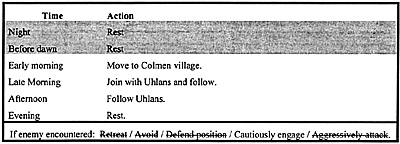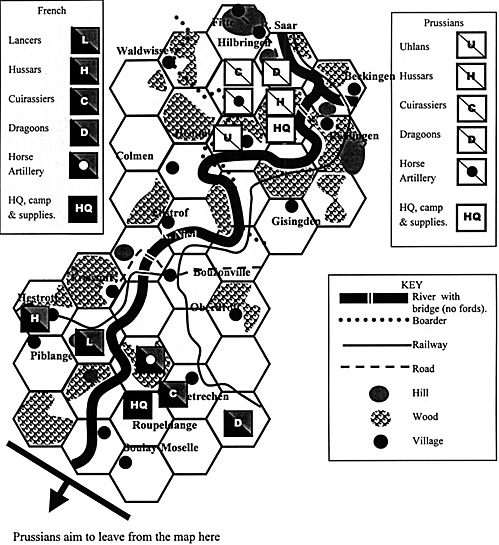The Solo Wargamer’s Association ADC service provides a temporary opponent to assist solo players with their wargames. I have made use of the service a few times now and have helped others by acting as an ADC. I have always found the resulting games very stimulating and enjoyable. Having recently moved overseas I have found that airmail letters rather slow, expensive and awkward to organise. Having access to the Internet I decided to try out the ADC service via email. This article explains how a mini-campaign and battles were played with an ADC through email contacts.
Initially I sent my ADC opponent the following information and maps and blank copies of the orders sheets. This was achieved by sending the documents as attachments to email messages (having first checked that the ADC had access to the same word processor software as I was using). The wargame was to take the form of a mini-campaign that required the ADC to take on the role of divisional commander of the Prussian forces.
Scenario
This is the second week of August 1870. The Prussians have launched an attack on the French defended frontier that began last week. The initial assault resulted in the Prussian 3rd Army attempting to take Thionville by storm but was repulsed by the French IV infantry corps. This week the Prussians have withdrawn from around Thionville and are massing their 1st and 2nd armies to attack Bitsch that is defended by the French V corps. Near Thionville the Prussian 5th cavalry division has been ordered to break through the French lines and to disrupt the French supply lines. Unfortunately, for the Prussian cavalry, a French cavalry division blocks their way.
Objectives
The Prussian aim is to leave the campaign map along the side where the River Nied enters near the village of Roupeldange with most of their force intact. Any of the three hexes on this side can be used as a successful exit route. This needs to be achieved within three days.
The French aim is to prevent the Prussians passing the current French line.
Map
The map is split into hexes that represent about a mile across. Villages or compass directions from villages can identify hex locations on the map e.g. the Prussian Cuirassiers and Horse Artillery are a mile north of Hemmersdor, the French Horse Artillery is a mile north-west of Tetrechen.
Areas off the map may be crossed by outflanking marches but with potential problems. As the French forces (IV infantry corps to the north and Bazaine army to the south) have pickets in these areas there is a good chance flank marches will be delayed and a small chance that they may be ambushed.
The rivers (Nied and Saar) can only be crossed at the railway or road bridges.
Movement
Movement rates depend on how close the unit is to its HQ, which also represents the encampment, and supply centre of the division/corps: the closer the better. Weather and roads also affect movement rates.
There are four move turns per day and two night turns. Units must rest one turn after three consecutive movement turns.
Units may move one more turn before resting as a forced march but they will be exhausted and will have reduced morale if they must fight during the forced march turn or rest period after.
HQ can not make forced marches or outflanking marches.
Maximum movement rates per turn:
| Type | HQ, infantry artillery | Light infantry, horse artillery | Cavalry | Light cavalry |
|---|---|---|---|---|
| Hexes | 2 | 3 | 4 | 5 |
Throw a D6 per move if more that 2 access hexes from HQ.
| Hex distance | 3-4 | 5-6 | 7-8 | 9+ |
|---|---|---|---|---|
| D6 score need to move each hex | 2-6 | 3-6 | 4-6 | 5,6 |
Weather (check every other move period):
| Type | Summer (06-08) | Autumn (09-11) | Winter (12-02) | Spring (03-05) |
|---|---|---|---|---|
| Fine | 3-6 | 4-6 | 5-6 | 4-6 |
| Wet | 2 | 2-3 | 3-4 | 2-3 |
| Extreme | 1 | 1 | 1-2 | 1 |
Wet weather = half movement off roads.
Extreme weather = half all movement, two moves before rest period required.
Caution: troops can get lost on night marches!
Throw D6 per hex moved at night:
- 1 unit goes left instead of straight.
2-5 unit goes on the correct route.
6 unit goes right instead of straight.
Force keeps going until distance intended is reached or wrong village discovered then halts until daylight.
If the force is ordered to engage enemy and comes across friendly troops at night D6=1 means they will attack friendly troops with this result D6:
- 1 A unit from each side suffers 25% casualties: both sides fall back 1 hex in opposite directions.
2 A unit from one side suffers 25% casualties and that side falls back one hex away from the other force.
3 There is an exchange of fire: both sides fall back 1 hex in opposite directions.
4 There is an exchange of fire: one side falls back 1 hex away from the other force.
5,6 Exchange of fire but mistake quickly established.
Combat
When enemy forces are in adjacent hexes and combat orders indicate action then forces will be deployed on the wargames table and the battle fought out.
Weapon ranges for small arms are less than a hex, more like half a hex for cavalry carbines. Light cavalry can fight dismounted with their carbines if you choose. (This practice was found successful during the Franco-Prussian War when cavalry was forced to defend villages, etc., but the practice was still considered far too undignified for the heavy cavalry.) Artillery ranges are just a bit more than the rifle ranges, about one and a half hexes.
Orders
This mini campaign will last three nights and days. Orders need to be written for all units on a daily basis. These orders need to specify when to move and rest for each of the two night and four day periods. Destinations need to be given. Basic actions to be undertaken if enemy units are encountered while also need stating. This is what the unit will do while couriers report the presence of the enemy to HQ and collect new orders.
Example or a horse artillery unit:


Back to Table of Contents -- Lone Warrior #133
Back to Lone Warrior List of Issues
Back to MagWeb Magazine List
© Copyright 2001 by Solo Wargamers Association.
This article appears in MagWeb (Magazine Web) on the Internet World Wide Web.
Other military history articles and gaming articles are available at http://www.magweb.com
